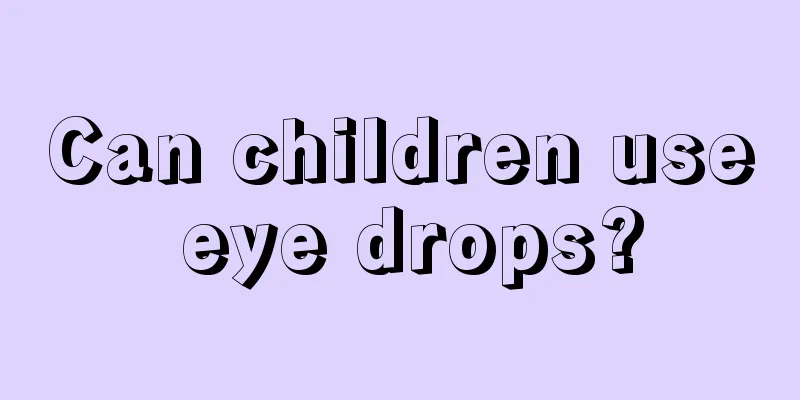Can children use eye drops?

|
Eye inflammation, trauma, before and after eye surgery, and mydriasis eye examination for adolescents all require the use of eye drops or eye ointments. The proper method and frequency of applying eye drops can cure the disease. On the contrary, improper use of medication or inappropriate methods will not only fail to achieve the desired effect, but may sometimes even lead to serious consequences. So, how do you use the right eye drops? Can children use eye drops? Let me tell you about it below. Topical ophthalmic medications include drops and eye ointments. Drops are generally aqueous solutions, but there are also oil solutions (such as cod liver oil drops) and suspensions. Eye ointment has a certain protective and lubricating effect. The drug stays in the eye for a longer time and the drug effect is more lasting. Before taking any medicine, you must strictly check the drug name, concentration, and eye type to avoid making any mistakes. When giving medicine to children, the first thing to do is to relieve their psychological fear and obtain their cooperation. How to use eye drops: Have your child lie on his back or sit up with his head tilted back slightly and his eyes looking up. The operator uses the left thumb or a cotton swab to gently pull open the child's lower eyelid to expose the lower conjunctival sac. Holding the eye dropper or eye dropper in the right hand, the operator drops eye drops into the conjunctival sac. The operator then slightly lifts the upper eyelid and gently closes it to fill the entire conjunctival sac with eye drops. Instruct the child to close his eyes for 1-2 minutes. If there is secretion or eye ointment on the eyes, it should be wiped off with a sterile cotton swab before applying eye drops. How to apply eye ointment After exposing the lower conjunctival sac, hold the eye ointment bottle and squeeze a rice-sized amount of medicine directly into the conjunctival sac. Ask the patient to close his eyes for 2-3 minutes to help the eye ointment dissolve and distribute in the conjunctival sac, and use a cotton swab or cotton ball to wipe off the ointment on the eyelid margin and eyelashes. For young and uncooperative infants, the cooperation of an assistant is needed. The operator and the assistant sit opposite each other, the child lies on his back on the assistant's knees, with his legs clasped under the assistant's armpits and his head fixed between the operator's knees. The assistant holds the child's arms and body. After the position is fixed, the medicine can be dripped. The editor reminds that when giving eye drops to children, the best posture is to place the child on his back on the bed or table, have one person hold his arms, upper body and legs, and another person hold his head with his hands, and the operator then applies the medicine. In addition, the editor does not recommend frequently using eye drops in children, as excessive use will cause them to become dependent on the drops. |
<<: Can children grow taller by running?
>>: What medicine should children take for viral colds?
Recommend
Treatment of congenital heart disease in children
I don't know if you have heard of congenital ...
What to do if your baby can't speak clearly
In daily life, every couple in every family wants...
Massage method for baby's throat inflammation
It is quite common for babies to have sore throat...
What to do if your two-year-old baby speaks late
When a child says his first word or calls "M...
What to do if the baby falls to the ground
Many parents are first-time parents and do not ha...
Baby's forehead hit big bump
Every baby is an angel sent by God, born lively, ...
What is the best medicine for disinfecting a baby's belly button?
Everyone knows that babies have different physica...
What to do if your child has a fever and a flushed face
I wonder if parents have noticed that during the ...
How to treat a four-month-old baby's stomach and intestines?
We all know that babies need to add some compleme...
Symptoms of a baby swallowing a coin
When children are infants, their brains are in a ...
What should I do if my child has edema of the foreskin of his penis?
The foreskin has edema, which is a common phenome...
Can little girls drink honey water?
Because children's gastrointestinal functions...
How to remove the red spots on babies caused by mosquito bites
Children's skin is relatively delicate. In th...
How long after feeding should you put your baby down?
Raising a child is not an easy process because ch...
Does fumigation with vinegar have any effect on newborns?
We all know that the bodies of newborns are relat...









